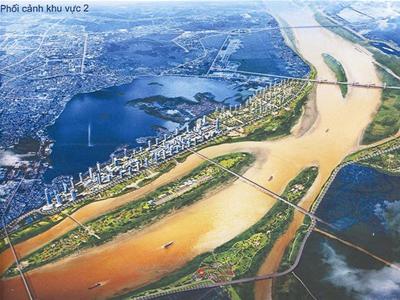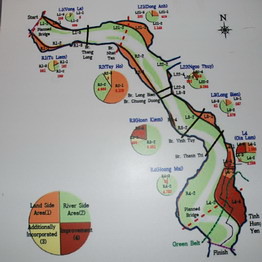Hanoi’s city government is asking the Prime Minister to authorize a visionary plan for development of the banks of the Red River from north of the airport bridge south to the Bat Trang pottery village. The costs would be financed by Korean private sources and development assistance funds.
In South Korea, on July 29, Hanoi Mayor Nguyen The Thao and Seoul Mayor O See Hoon signed an agreement on further technical assistance by Korea to the second phase of a controversial US$7 billion development project along both banks of Hanoi’s Red River.
Experts have said that the problematic parts of the visionary project are raising capital and site clearance. The project needs more than $7 billion of investment and 170,000 people have to be moved between now and 2020.
Seoul City Planning Department head Song Deuk Boum told reporters that the money problem has been solved. Many Korean investors are willing to participate in this project, he explained, so the remaining problem is how to relocate the 39,000 households who now populate the Red River flood plain as it passes through Hanoi.
The developers propose to build a new 42 kilometer dike on the river’s eastern side and upgrade the current 33.8km dike on the river’s western side.

Discussion of the Red River development plan began in 2006. Vietnamese and Korean experts presented a draft plan in 2007. The plan envisions a new urban center rising on either side of the river, an area of international financial buildings, high-class apartment buildings and parks, and ample green space.
Now, with a technical assessment completed and the concept agreed in principle, a detailed plan including its financing scheme will be prepared for review by Vietnam’s National Evaluation Council and eventual consideration by the Prime Minister’s Office and the National Assembly.
The plan addresses four areas, totalling 2462 hectares. Zone I is from Chem to the Thang Long (airport) Bridge; Zone II from the Thang Long Bridge to the Chuong Duong Bridge that links central Hanoi and Gia Lam; Zone III from the Chuong Duong Bridge to the new Thanh Tri Bridge; and Zone IV from the Thanh Tri Bridge to Bat Trang, the pottery village.
Zone II is the heart of the project. It is also divided into two zones. Zone II-a, 500 hectares, will be densely developed with international hi-tech zones and luxurious apartment buildings. Zone II-b, 370 hectares, will hold a residential area, stadium, international exhibition centre, tourism and entertainment zones.
The plan forsees that ultimately the redeveloped riverfront will be home to 97,000 households in the future, using 50 percent of the area. It defines other sites for the construction of parks, tourism and cultural zones along the riverfront. For example, Vong La would be developed into an ecological preservation area, Dong Anh would hold a complex of general sport parks, Ngoc Thuy would be a resort, Long Bien as an ecological study and discovery site, Tu Liem an riverside ecological recovery zone and Tay Ho a park for urban residents.

The concept is modeled on South Korea’s combined flood control and land reclamation projects implemented along the Han River in the Seoul megalopolis. The Korean experts have proposed estensive measures to control flooding, ensure drainage and stabilize the riverbanks.
If the plan goes forward, about 4,500 households living between Chem and the Thang Long bridge (Zone I) will be relocated by 2012. About 23,900 households living from the Thang Long bridge to the Thanh Tri bridge (Zones II and III) will be relocated between 2013 and 2016, and 6,700 between the Thanh Tri bridge and the Bat Trang Pottery village (Zone IV) from 2016 to 2020.
Of the total capital required for this huge project, $7.1 billion, $1.9 billion is earmarked for construction and $1.6 billion for site clearance and compensation for local residents. According to Korean experts, funding for the project will include both private capital and Korean government assistance. Payback will be realized from the sales of land and houses.
The Hanoi Department of Planning and Architecture introduced this plan at the Trang Tien Exhibition Hall in September 2007. After nearly one year spent in collecting opinions from the people and experts, the draft plan was amended and made public in late 2008. It has been reported that 37.8 percent those who studied the model agreed with the project completely; 30.5 percent agreed with most elements of the project; 27 percent agreed with a part of this project and 4.6 percent didn’t agree at all. Many people doubted the project’s feasibility because of its huge investment capital, the number of people who have to be resettled, problems of flood control in the Red River, and environmental and cultural impacts.
The Hanoi authorities determined to go ahead with the Red River project early in July. People’s Committee Chairman Nguyen The Thao formally requested to Prime Minister Nguyen Tan Dung to urge Seoul to assist Hanoi technically and financially, with a view to have the plan’s early approval and completion under an agreement between the chief executives of Hanoi and Seoul.
Seoul City also promised to help Hanoi clean the polluted To Lich river and organize its 1000th anniversary celebration.
Source: VNN/Cong Thuong
In South Korea, on July 29, Hanoi Mayor Nguyen The Thao and Seoul Mayor O See Hoon signed an agreement on further technical assistance by Korea to the second phase of a controversial US$7 billion development project along both banks of Hanoi’s Red River.
Experts have said that the problematic parts of the visionary project are raising capital and site clearance. The project needs more than $7 billion of investment and 170,000 people have to be moved between now and 2020.
Seoul City Planning Department head Song Deuk Boum told reporters that the money problem has been solved. Many Korean investors are willing to participate in this project, he explained, so the remaining problem is how to relocate the 39,000 households who now populate the Red River flood plain as it passes through Hanoi.
The developers propose to build a new 42 kilometer dike on the river’s eastern side and upgrade the current 33.8km dike on the river’s western side.

Discussion of the Red River development plan began in 2006. Vietnamese and Korean experts presented a draft plan in 2007. The plan envisions a new urban center rising on either side of the river, an area of international financial buildings, high-class apartment buildings and parks, and ample green space.
Now, with a technical assessment completed and the concept agreed in principle, a detailed plan including its financing scheme will be prepared for review by Vietnam’s National Evaluation Council and eventual consideration by the Prime Minister’s Office and the National Assembly.
The plan addresses four areas, totalling 2462 hectares. Zone I is from Chem to the Thang Long (airport) Bridge; Zone II from the Thang Long Bridge to the Chuong Duong Bridge that links central Hanoi and Gia Lam; Zone III from the Chuong Duong Bridge to the new Thanh Tri Bridge; and Zone IV from the Thanh Tri Bridge to Bat Trang, the pottery village.
Zone II is the heart of the project. It is also divided into two zones. Zone II-a, 500 hectares, will be densely developed with international hi-tech zones and luxurious apartment buildings. Zone II-b, 370 hectares, will hold a residential area, stadium, international exhibition centre, tourism and entertainment zones.
The plan forsees that ultimately the redeveloped riverfront will be home to 97,000 households in the future, using 50 percent of the area. It defines other sites for the construction of parks, tourism and cultural zones along the riverfront. For example, Vong La would be developed into an ecological preservation area, Dong Anh would hold a complex of general sport parks, Ngoc Thuy would be a resort, Long Bien as an ecological study and discovery site, Tu Liem an riverside ecological recovery zone and Tay Ho a park for urban residents.

The concept is modeled on South Korea’s combined flood control and land reclamation projects implemented along the Han River in the Seoul megalopolis. The Korean experts have proposed estensive measures to control flooding, ensure drainage and stabilize the riverbanks.
If the plan goes forward, about 4,500 households living between Chem and the Thang Long bridge (Zone I) will be relocated by 2012. About 23,900 households living from the Thang Long bridge to the Thanh Tri bridge (Zones II and III) will be relocated between 2013 and 2016, and 6,700 between the Thanh Tri bridge and the Bat Trang Pottery village (Zone IV) from 2016 to 2020.
Of the total capital required for this huge project, $7.1 billion, $1.9 billion is earmarked for construction and $1.6 billion for site clearance and compensation for local residents. According to Korean experts, funding for the project will include both private capital and Korean government assistance. Payback will be realized from the sales of land and houses.
The Hanoi Department of Planning and Architecture introduced this plan at the Trang Tien Exhibition Hall in September 2007. After nearly one year spent in collecting opinions from the people and experts, the draft plan was amended and made public in late 2008. It has been reported that 37.8 percent those who studied the model agreed with the project completely; 30.5 percent agreed with most elements of the project; 27 percent agreed with a part of this project and 4.6 percent didn’t agree at all. Many people doubted the project’s feasibility because of its huge investment capital, the number of people who have to be resettled, problems of flood control in the Red River, and environmental and cultural impacts.
The Hanoi authorities determined to go ahead with the Red River project early in July. People’s Committee Chairman Nguyen The Thao formally requested to Prime Minister Nguyen Tan Dung to urge Seoul to assist Hanoi technically and financially, with a view to have the plan’s early approval and completion under an agreement between the chief executives of Hanoi and Seoul.
Seoul City also promised to help Hanoi clean the polluted To Lich river and organize its 1000th anniversary celebration.
Source: VNN/Cong Thuong


Post a Comment
Post a Comment